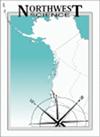华盛顿州和俄勒冈州林线山区铁杉气候-生长响应的时间变异
IF 0.5
4区 环境科学与生态学
Q4 ECOLOGY
引用次数: 3
摘要
垂直林木线森林的气候-生长关系提供了特别丰富的信息,因为它们代表了物种范围的上限,而这些物种的生长通常对气候变化特别敏感。径向生长对气候变量的响应通常从能源有限到水资源有限。在北美太平洋西北地区,林木线森林通常是能源有限的。最近的一项研究(Marcinkowski et al. 2015)的结果表明,华盛顿州北部林木线山铁杉(Tsuga mertensiana)的气候-生长关系随着时间的推移而变化。在这里,我们调查了这些相同的关系是否在俄勒冈州和华盛顿州700公里的树线山铁杉范围内成立。我们利用树龄在100 ~ 200年之间的树木的岩心,研究了自20世纪初以来气候-生长关系的时空变异。结果表明:1)森林生长在林木线上的能量限制可能减弱;2)随时间变化,森林生长对气候变量的响应是非平稳的;3)从北向南,森林生长对气候的响应模式不同。除了一些例外,同一地理位置不同方面的气候-生长关系基本相似。气候变量与径向增长之间的相关性随时间而变化(从显著正相关到显著负相关),表明气候增长关系的非平稳性。这些结果确定了生长限制变量可能在树线发生变化的位置。预计气候变化对树线生长的影响还会有其他变化,而且在时间上可能是复杂的。本文章由计算机程序翻译,如有差异,请以英文原文为准。
Temporal Variability in Climate-Growth Response of Mountain Hemlock at Treeline in Washington and Oregon
Abstract Climate-growth relationships in altitudinal treeline forests are particularly informative because they represent the upper limit of a species range where growth is often especially sensitive to climatic variation. Radial growth response to climatic variables typically ranges from energy limited to water limited. In the Pacific Northwest region of North America, treeline forests are typically energy limited. Results from a recent study (Marcinkowski et al. 2015) indicate a change in climate-growth relationships over time in treeline mountain hemlock (Tsuga mertensiana) in northern Washington state. Here, we investigate whether these same relationships hold across 700 km of the range of treeline mountain hemlock in Oregon and Washington. Using cores from trees > 200 years old, we examined temporal and spatial variability of climate-growth relationships since the early 20th century. Results indicate 1) a potential weakening of energy limitation in forest growth at treeline, 2) a nonstationary growth response to climate variables through time, and 3) different patterns of growth response to climate from north to south. Climate-growth relationships were generally similar between different aspects in the same geographic location, with some exceptions. Correlations between climate variables and radial growth differ over time (ranging from significantly positive to significantly negative), indicating the non-stationary nature of climate-growth relationships. These results identify where changes in growth-limiting variables may be occurring at treeline. Additional changes in the effects of climate change on growth at treeline are expected, and may be temporally complex.
求助全文
通过发布文献求助,成功后即可免费获取论文全文。
去求助
来源期刊

Northwest Science
环境科学-生态学
CiteScore
1.30
自引率
0.00%
发文量
23
审稿时长
>36 weeks
期刊介绍:
The pages of Northwest Science are open to original and fundamental research in the basic, applied, and social sciences. All submissions are refereed by at least two qualified peer reviewers. Papers are welcome from authors outside of the Pacific Northwest if the topic is suitable to our regional audience.
 求助内容:
求助内容: 应助结果提醒方式:
应助结果提醒方式:


